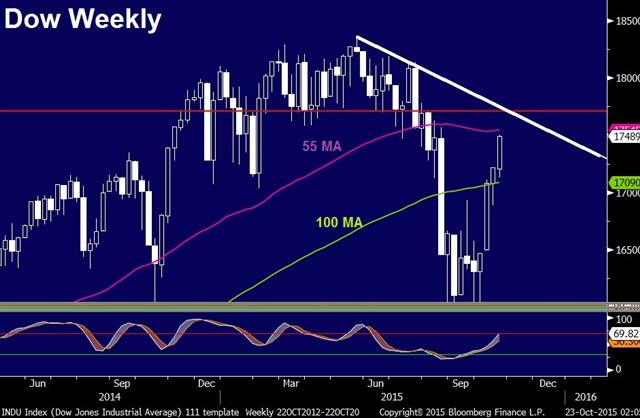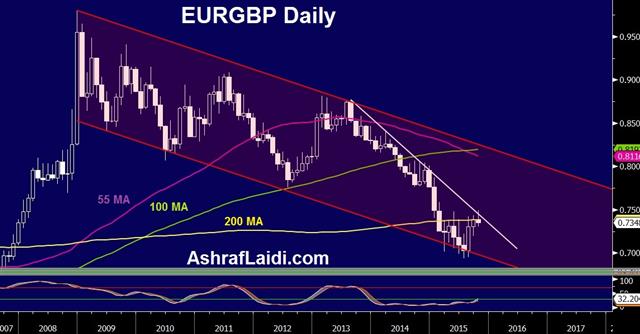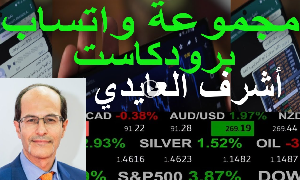Intraday Market Thoughts Archives
Displaying results for week of Oct 18, 2015The only Thing worse than Dovish Talk
…is dovish talk with a deadline to act. That's what Draghi delivered on Thursday when he said the ECB will re-examine the degree of accommodation at the Dec 3 meeting. The euro was easily the worst performer while commodity FX led. The China Caxin manufacturing PMI is on a number of economic calendars but it won't be released in the hours ahead. The EURUSD Premium Insights short wad stopped out as well as one of the two DAX shorts. A new note has been added on GBPCAD and USDJPY.

Adding a time element to when the ECB will act makes it especially hard to buy the euro. It gives shorts a target date that's six weeks away. Draghi didn't promise to ease but he's an experienced central banker who chooses his words carefully. The market will expect an expansion of QE to 70-80 billion euros per month from 60 billion euro and, perhaps, a 10 basis point cut in the deposit rate.
The type of surprise he delivered tends to last, especially with the way the euro cut through the 200-day moving average after already falling 200 pips on the day. The modest sizes of intraday bounces were also evidence of a market with few willing buyers.
The winners on more ECB easing aren't only euro crosses. The European bond market absolutely cheered the news, driving Spanish yields down 15.5 bps to 1.48% -- a level that would have been unthinkable a few years ago. The transmission mechanism to corporates isn't as strong in Europe but rates that cheap are very good news for European equities and SMEs.
Gold held steady in US dollar terms but climbed higher elsewhere. Opening the door to more QE underscores the desire of central bankers to print and inflate. That's good news for hard assets.
The market will undoubtedly be less volatile as the week winds down and that may lead to some consolidation. One element that will remove some volatility is the discontinuation of the Caixin (formerly HSBC) manufacturing survey. It was one of the few trusted, private economic data points and no reason was given for its cancellation shortly after Caixin acquired the rights to it. It leaves us further in the dark about China's economy.
Yesterday there were rumors that Chinese government agencies would halt stock market intervention but a late rally showed that may not be true. We'll be watching closely Friday.
| Act | Exp | Prev | GMT |
|---|---|---|---|
| Markit Manufacturing PMI (OCT) [P] | |||
| 52.8 | 53.1 | Oct 23 13:45 | |
| Eurozone Markit PMI Composite (OCT) [P] | |||
| 53.5 | 53.6 | Oct 23 8:00 | |
| Eurozone Markit PMI Manufacturing (OCT) [P] | |||
| 51.8 | 52.0 | Oct 23 8:00 | |
| Eurozone Markit Services PMI (OCT) [P] | |||
| 53.5 | 53.7 | Oct 23 8:00 | |
CAD Back on the Defensive
There are 55 reasons to watch the Canadian dollar in the day ahead. The loonie was the worst performer Wednesday after the BOC decision while the US dollar led the way. Later, the Asia-Pacific calendar is focused on AUD.
USD/CAD is flirting with the 55-day moving average after its largest one-day gain since May. The pair climbed 150 pips after the Bank of Canada decision. There was no change in rates and the BOC guidance remained neutral but forecasts revealed a dovish shift.
The BOC closely monitors the output gap which is the amount of spare capacity in the economy or how much growth is possible before it creates inflation. It's the metric around which BOC decisions are made. The BOC had predicted it would close in H1 2017 but pushed that out to mid-2017 after lowering growth forecasts in 2015 and 2016.
They also lowered inflation forecasts for next year and that leaves little room for more slack before the BOC will cut rates to 0.25% from the current 0.50% overnight rate.
If that happens may depend largely on oil. To underscore CAD's dependency on oil, WTI crude is also flirting with the 55-dma. It's at $44.86 which is precisely what the low was Wednesday. Oil prices declined after US inventories expanded another 8m barrels after a 7.6m build last week. The market was looking for just a 3.9m barrel increase.
As oil goes, so will CAD. A third factor could topple or support both. The worries in broader markets began to percolate in Chinese stocks yesterday as the Shanghai Composite fell 3.1% after touching a 7-week high earlier. It's the largest one-day decline since Aug 25 however the losses were pared by about 1% late in trading.
We'll keep a close eye on China in the day ahead. What happens there will also drive the Australian dollar along with a speech from the RBA's Edey at 2245 GMT and NAB business confidence at 0030 GMT. Otherwise the Asia-Pacific calendar is light.
| Act | Exp | Prev | GMT |
|---|---|---|---|
| BoC Rate Decision (OCT 21) | |||
| 0.5% | 0.5% | 0.5% | Oct 21 14:00 |
Ashraf’s seminar at XTB’s Trading Masterclass in London on Oct 29
You are invited to attend Ashraf's key note speech at XTB's London headquarters on October 29th at in Canada Wharf. Ashraf will be joined by special guest speakers to share his experience on integrating multiple time-frames into your trading strategies. An interactive Q&A session will follow.
At XTB's Trading Masterclass, you will:
● Engage in an interactive Q&A session with professional traders
● See expert investors analysing markets in real-time
● Learn how to apply multiple time-frames of analysis to your strategies
To reserve your place, please click here.
Volatility Down, but not Out
The theme over past week in financial markets has been less volatility and that continued Tuesday but there are reasons for continued worry. CAD bounced back and was the top performer on the day while the kiwi lagged after a soft dairy auction. A handful of economic releases are due up in Asia-Pacific trading. The latest from Ashraf's Premium Insights, includes tghe addition of both English and Arabic videos, focusing on equity indices-- SPX & Dow found on 0:50 mins to 9:00 mins -- FTSE on 9:00- 11:35 mins--and on FX, spanning from 11:35 to 26:40 mins).

FX traded mostly in tight rages and the S&P 500 daily range was less than 14 points for the third straight day. The ebb in volatility is a good signal for risk assets, and it's helped to boost commodity currencies since the start of the month.
The main driver remains China. A five-day holiday at the beginning of the month calmed markets and that's slowly percolated. The Shanghai Composite hit a seven week high on Tuesday has now climbed 20% since the Aug 26 low.
Markets have come to terms with slower emerging market growth and middling (at best) developed economies. A return to high volatility is inevitable; here are the places, which could spark it.
1. China – Growth numbers helped to calm fears but no one is certain how the economy is performing. The data docket is light until the first days of November so that argues for a continued moderation.
2. Other emerging markets – Brazil is in near-crisis mode and frontier markets have been battered. In the ultra-connected economy a genuine crisis could easily spill over to the financial sector and beyond.
3. The fall in margin debt – Ashraf's analysis on margin debt argues that the stabilizing forces present in markets for the past 8 years are fading. That doesn't necessarily mean trouble is coming but when it comes, it means the moves will be more dramatic.
4. Oil – OPEC meets for a 'technical' meeting Wednesday with Russia, Mexico and some other non-members present. Oil inventories in the US continue to surge and a collapse in oil prices could easily spread to high yield or be the trigger for emerging market worries.
Guarding against these risks will be the theme for months and sorting through what's real or an overblown fear is the challenge.
In the shorter term, central banks are in focus, including the Bank of Canada on Wednesday. In Asia-Pacific trading, Japanese trade balance is due at 2350 GMT. Hopes for BOJ stimulus this month have faded but poor trade could rekindle the chatter. The Aussie skilled vacancies report at 0000 GMT and Japan's all-industry index at 0430 GMT are also notable.
| Act | Exp | Prev | GMT |
|---|---|---|---|
| Adjusted Merchandise Trade Balance (SEP) | |||
| ¥-358.8B | Oct 20 23:50 | ||
| Merchandise Trade Balance Total (SEP) | |||
| ¥84.4B | ¥-569.7B | Oct 20 23:50 | |
| All Industry Activity Index (AUG) (m/m) | |||
| -0.1% | 0.2% | Oct 21 4:30 | |
Margin Debt Decline Biggest since 2011
Margin debt balances at NYSE member firms sustained a $19.5 billion decline (-4.1%) in September, the biggest monthly fall in margin utilisation since August 2011 ($33.9 billion or -11%), when the Eurozone markets were damaged by heightened fears of an Italy exit from the Eurozone and the US credit rating was downgraded by S&P. The September decline marks the 3rd consecutive monthly drop— the longest losing streak since 2011.

Worse than 2011?
Such recurring comparisons to 2011 lead us to reiterate the point that today's macro and market dynamics are more worrisome than four years ago. Here is why:1. The global economy was supported by vital portfolio and infrastructure investments from China and the Gulf nations. Today, China is at the cusp of a deflating credit bubble and the effect of its falling demand is extending onto US household stocks (WalMart, Apple and Caterpillar).
2. China's currency devaluation may ease the threat on exporters and relieve the currency headwind on USD-denominated borrowers, but its impact on the rest of the world is the antithesis of QEs from the Bank of Japan and European Central Bank.
3. Gulf nations' retreat. Injections from MidEast and FarEast sovereign wealth funds were instrumental in stabilizing global markets in 2007-9. Today, reports that Saudi Arabia's Monetary Authority has withdrawn as much as $70 bn over the past six months along with Qatar's stock holding losses in Glencore and Volkswagen have sobering implications for global liquidity as these restructure their portfolios to withstand budget imbalances resulting from falling energy prices.
4. Unlike in 2011 when Fed's QE was seen as a “novelty” and neither the ECB nor the BoJ had yet contributed with their stimulus, today's economy is all QEd out to the point that the IMF and central bankers are admitting to the limitations of prolonged QE.
5. Slowing global trade, deepening China macro retreat, plunging commodities, falling capex and +$1.5 trillion in cancelled oil projects are all witnessed today. These were certainly not present in 2011.
Margin calls & forced selling
The high correlation between margin debt and equities reflects the increasing use of debt in purchasing stocks by institutional and retail investors, shedding important light on the circular loop between price performance and the use of margin debt.1-3 month lags
July 1998 – The stock market top of July 1998 coincided with the peak in margin debt before the decline was propagated by the EM fallout & LTCM collapse.March 2000 -- The peak in margin debt of March 2000 coincided with the market high in the S&P500 right before the burst of the dotcom bubble, which was intensified by a new generation of margined trading, made easy by online trading.
July 2007 -- The peak in margin debt of July 2007 occurred three months prior to the pre-crisis top in the market.
The 1-month lag has reappeared as the latest margin debt figures show leverage has fallen 10% from its April peak -- one month prior to the record high in the S&P500 and the Dow. The stock market's bounce of the last four weeks is likely to remain with us until early November, with additional gains fading at the +3% threshold. Our subscribers have already taken positons in the Dax and the FTSE-100.
CAD Slumps Ahead of Election
The FX market struggled to find a theme on Monday with newsflow relatively light. The Canadian dollar was hit by falling oil prices and election uncertainty while the pound was the top performer. The election results and RBA Minutes are due in Asia-Pacific trading. A new Premium trade in FTSE-100 was created with 3 explanatory charts and the fundamental rationale. The existing GBPCAD Premium trade will be updated with a new chart ahead of Tuesday's UK retail sales.

Canadians headed to the polls Monday in an election that's likely to significantly weaken and probably defeat Prime Minister Harper. The Liberal Party and Justin Trudeau lead the polls by 6-8 points and is likely to win a minority government. However, with vote splits Harper's Conservatives could win a minority and that may lead to a gridlock and showdown as other parties have pledged not to work with him. He could wait as long as three months to recall Parliament in that case and the uncertainty could hurt CAD. Other election scenarios are probably CAD-neutral with no main parties proposing (or likely to undertake) anything far from the status quo.
The CAD decline Monday reflected some uncertainty but the 2.3% decline in oil prices were the larger factor.
GBP was the top performer ahead of UK retail sales, but trimmed its gains to 1.5460 from 1.5497 as the 100-day moving average continued to offer resistance.
The Australian dollar also drifted lower to 0.7250 from 0.7300 as sentiment deteriorated. The US dollar got some help from the Fed's Williams who said he prefers to hike sooner and more gradually. It will remain in focus with the RBA Minutes due at 0030 GMT.
The reaction to the statement was heavy AUD buying for several days afterwards as dovish rhetoric never materialized. That skews some risks toward more dovish Minutes with more FX jawboning. If so, the Australian dollar could be vulnerable if Friday's low of 0.7236 gives way. The Oct 12 low of 0.7197 would then come into focus.
| Act | Exp | Prev | GMT |
|---|---|---|---|
| FOMC's Powell Speech | |||
| Oct 20 13:15 | |||
| Fed's William Dudley speech | |||
| Oct 20 13:30 | |||
| Fed's Yellen Speech | |||
| Oct 20 15:00 | |||







